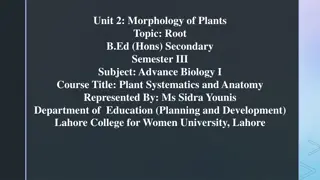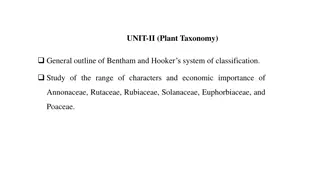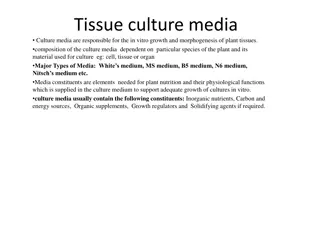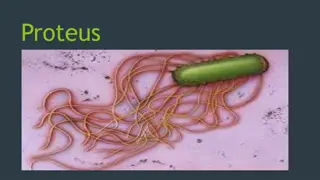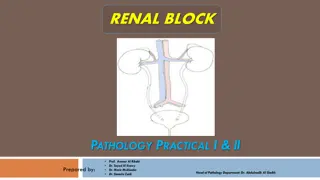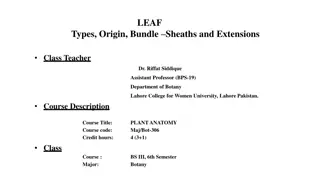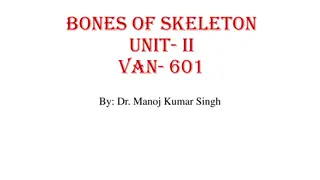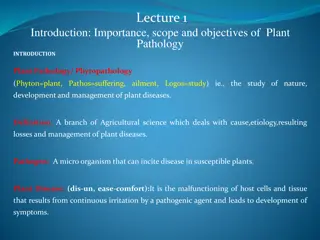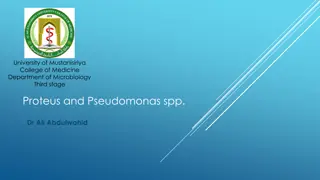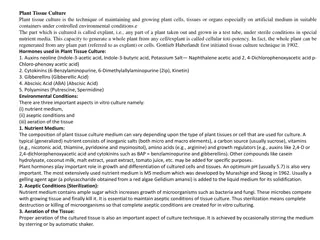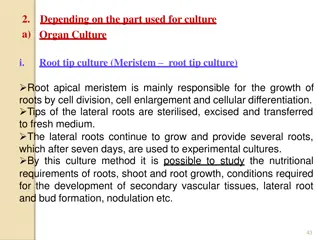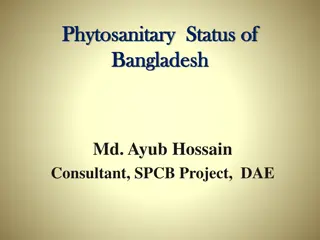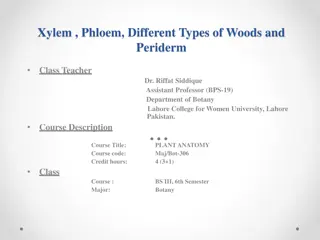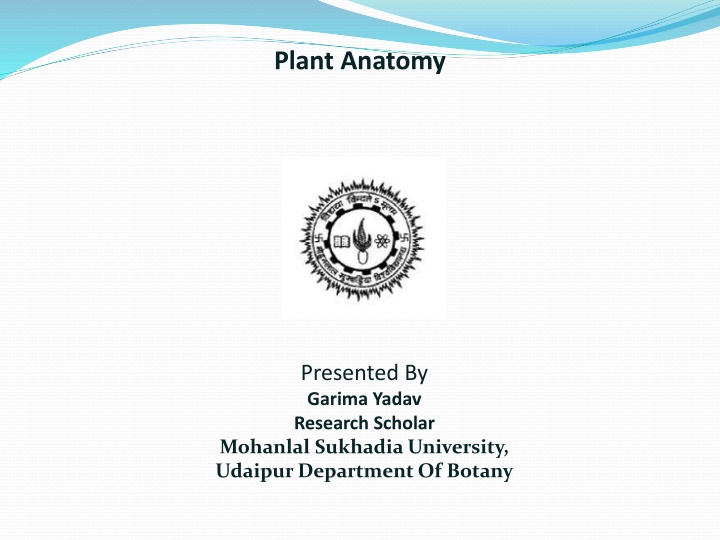
Plant Anatomy Overview by Garima Yadav: Achyranthes and Amaranthus Sections
Explore the detailed plant anatomy presented by Garima Yadav, a research scholar at Mohanlal Sukhadia University, Udaipur. The sections of Achyranthes and Amaranthus are examined, highlighting key features such as epidermis, cortex, endodermis, pericycle, vascular tissue system, pith, and more. Detailed observations of the transverse sections reveal the structural components and organization of these plant species.
Download Presentation

Please find below an Image/Link to download the presentation.
The content on the website is provided AS IS for your information and personal use only. It may not be sold, licensed, or shared on other websites without obtaining consent from the author. If you encounter any issues during the download, it is possible that the publisher has removed the file from their server.
You are allowed to download the files provided on this website for personal or commercial use, subject to the condition that they are used lawfully. All files are the property of their respective owners.
The content on the website is provided AS IS for your information and personal use only. It may not be sold, licensed, or shared on other websites without obtaining consent from the author.
E N D
Presentation Transcript
Plant Anatomy Presented By Garima Yadav Research Scholar Mohanlal Sukhadia University, Udaipur Department Of Botany
Achyranthes Cut a transverse .section of the material, stain in safranin and fast green combination and mount in glycerin. Observations: The transverse section is almost circular in outline and shows ridges and furrows. Epidermis: This is the outermost layer of thickly cuticularised cells. Multicellular and uni-or multiseriate hairs are present. Cortex: It is differentiated into collenchyma, chlorenchyma and parenchyma. Collenchyma occurs in patches just below the ridges. Chlorenchyma forms a few layers below the epidermis in the grooves or between the two collenchymatous patches. Three to four cells deep parenchyma forms innermost region of the cortex.
Endodermis. Distinct casparian strips are absent. The layer is almost indistinguishable after the secondary growth. ' Pericycle. It lies immediately outside the vascular tissues. It consists of 3 to 4 cells deep groups of sclerenchyma. Vascular tissue system. It consists of secondary tissues and a small pith. The, primary phloem forms groups of crushed tissues. It 'is followed by a ring of secondary phloem. The cells include sieve tubes, companion cells and phloem parenchyma. A ring of cambium lies below the phloem and separates the underlying zone of secondary xylem. Secondary xylem consists of many vascular bundles embedded in prosenchyma. In this region, there is no differentiation between secondary xylem elements and the prosenchyma. A few large vessels can, however, be seen prominently. Phloem groups of the embedded vascular bundles appear as embedded patches in the thick walled prosenchyma. These are called as included phloem or phloem islands or interxylary phloem. Primary xylem groups lie near the pith. Protoxylem elements are endarch. The vascular bundles, thus, would be conjoint, collateral, endarch and open.
Pith: A well developed parenchymatous pith is present in the centre. Two medullary vascular bundles are present in the centre with their xylem facing each other. Identification Stem. Vascular bundles conjoint, collateral and endarch. Dicotyledonous stem. 1. Well differentiated cortex. Vascular bundles arranged in a ring. Presence of secondary growth. Points of interest Medullary bundles. The number and arrangement of medullary bundles is not constant throughout. However, generally two medullary bundles occur in the centre of the pith throughout the length of the plant. These are said to be leaf traces in nature. Secondary growth. An extra stelar cambium appears in the form of small arcs in the region of pericycle. These strips of cambia produce secondary vascular bundles which remain scattered in the beginning. The conjunctive tissue (prosenchyma) becomes lignified. The vascular bundles get embedded in the prosenchyma and differentiation between xylem and prosenchyma becomes difficult. However, thin walled phloem of the secondary vascular bundles appears as distinct patches in the lignified secondary tissues. It is variously called as 'phloem islands', interxylary phloem and included phloem.
Amaranthus The outline of the section is almost circular. Epidermis: o It is an outermost layer of barrel to rectangular cells. o The cells are thickly cuticularised. o A few stomata occur in the epidermis. o A few unicellular or multicellular hairs may be present. Cortex: o It is many layered and differentiated into (a) collenchyma and (b) parenchyma. o A few layered collenchymatous hypodermis follows epidermis. It is 3-5 layered deep. o Parenchyma follows collenchymatous hypodermis. It is a few cells deep. The cells are spherical to oval. The cells may contain a few to many chloroplasts. Endodermis: o A distinct endodermis with Casparian strips is absent. o A prominent starch sheath is present in its place.
Pericycle: o It is represented by a few sclerenchymatous cells in the old stems. Vascular tissue system: o A large zone of vascular tissues lies just below the starch sheath. o Starch sheath is followed by a large amount of conjunctive tissue in which secondary vascular bundles are embedded. o Secondary phloem is situated just below the starch sheath. It is found in small groups. o Two-layered ring of cambium separates secondary phloem from secondary xylem. o Secondary xylem of secondary vascular bundle lies below the cambium. o This secondary xylem is embedded in conjunctive tissue that appears as a complete ring below the o cambium. Conjunctive tissue is made of thick walled parenchyma. o Numerous vascular bundles are scattered in the centrally located parenchymatous pith. These are primary vascular bundles and are called medullary bundles. Pith: o The central part of the section has a large parenchymatous pith. o Medullary bundles in the pith are conjoint, collateral, endarch and open. o Cambial activity takes place in these medullary bundles. Hence, a little amount of secondary phloem and secondary xylem are also present.
Identification o Stem.: 1. Cortex is well differentiated. 2. Vascular bundles are conjoint, collateral and endarch. o Dicotyledonous stem. 1. Starch sheath is distinguishable. 2. Vascular bundles are arranged in a ring. 3. Secondary growth is present. Points of interest o In a stem numerous vascular bundles occur (a) in a ring embedded in conjunctive tissue and (b) scattered in the centrally located pith. o Secondary growth. In the beginning, there are numerous scattered primary vascular bundles. These bundles are collateral and open. The cambium of the bundles is active and individual bundles show little amount of secondary growth. This activity stops after some time. These bundles come to lie in the pith and are now called as medullary bundles. Secondary growth begins later with the development of a new cambium outside the stele. This cambium cuts off conjoint and collateral vascular bundles on the outer side. These are secondary bundles which remain embedded in the large amount of conjunctive tissue formed by the cambium. Such many rings of vascular bundles are formed which remain embedded in the conjunctive tissue and their phloem consequently gives an appearance of included phloem or phloem islands at number of places.
Mirabilis The transverse section is almost quadrangular in outline. Epidermis. 1. This is the outermost single layer of rectangular cells. 2. The cells are thickly cuticularised. 3. A few stomata and multicellular hairs are present in the epidermis. Cortex. 1. It is many layered and differentiated into (a) Collenchyma and (b) parenchyma. 2. Collenchymatous hypodermis follows. It is 4-5 layers deep. The cells are thickened at the corners. 3. Parenchymatous region follows hypodermis and forms a major part of cortex. This region extends upto endodermis. It is many layers deep. The cells contain numerous chloroplasts. Endodermis. 1. It separates cortex from the underlying vascular tissue. 2. This single layer of cells lacks casparian strips and is hence called starch sheath. Pericycle. 1. It lies immediately below endodermis and is a few layered thick. 2. The cells are parenchymatous.
Vascular tissue system. 1. It forms a wide zone below the pericycle. 2. Pericycle is followed by conjunctive tissue in which secondary vascular bundles are embedded. 3. Immediately following the pericycle are small groups of secondary phloem. 4. Secondary phloem is separated from secondary xylem by 2-3 layered ring of cambium. 5. Secondary xylem of secondary vascular bundle lies below the cambium. The amount of secondary xylem is much larger than secondary phloem. 6. This secondary xylem is embedded in a zone of conjunctive tissue. The conjunctive tissue is a thick walled parenchyma and almost indistinguishable from secondary xylem. 7. Numerous vascular bundles are scattered in the centrally located parenchymatous pith. These are primary vascular bundles, now called medullary bundles. Pith. 1. The central part of the section is occupied by a large parenchymatous pith. 2. Medullary bundles in the pith are conjoint, collateral, endarch and open. Those near the periphery are smaller in size and more crowded, whereas those in the central region are larger and less crowded. 3. A little amount of secondary growth takes place in the medullary bundles.
Identification. 1. Stem. 1. Cortex is well differentiated. 2. Vascular bundles are conjoint, collateral and endarch. 2. Dicotyledonous stem. 1. Starch sheath is distinguishable. 2. Vascular bundles in a ring. 3. Secondary growth present. Points of interest Young Mirabilis stem has many bundles which undergo secondary growth. Secondary growth: Primary vascular bundles in a young stem are conjoint, collateral, endarch and open. The cambium of the bundles is active and each vascular bundle undergoes a little amount of secondary growth. The activity of this cambium stops after some time. These vascular bundles come to lie in the pith and called medullary bundles. Secondary growth starts with the formation of secondary cambium originating in the parenchyma closer to pericycle. This cambium cuts off secondary xylem on its inner side. It remains embedded in thick walled conjunctive tissues. A very small amount of secondary phloem elements are formed by the cambium on its outer side. Due to successive cambial ring formation, rings of vascular tissues embedded in the conjunctive tissue are
Leptadenia The outline of the transverse section is almost circular. Epidermis. 1. It forms the outermost layer consisting of barrel-shaped cells. 2. A thick cuticle covers the epidermis. Cortex. 1. The cortex is made of outer hypodermis and the inner region of cortex itself. 2. Hypodermis is chlorenchymatous. It is four to five cells deep. The cells are thin walled and possess numerous chloroplasts. 3. The inner region of the cortex consists of thick walled sclerenchymatous cells. The thickenings show many pits. Endodermis: A distinct endodermis with casparian strips is absent. PericycIe: 1. It is represented by scattered groups of thick walled stone cells. 2. A wide zone of parenchymatous cells follows pericycle. It unmodified region of pericycle.
Vascular tissue system. 1. The vascular tissues occur in the following sequence-primary phloem, secondary phloem, cambium, secondary xylem, included phloem, primary xylem and internal or interxylary phloem. 2. Primary phloem is inconspicuous and forms small groups. 3. Secondary phloem forms a large and complete ring. 4. Secondary phloem and secondary xylem are separated by a unistratose layer of cambium. 5. Xylem consists of both primary and secondary tissues. These are made of tracheids, vessels, xylem parenchyma and conjunctive tissue. A wide zone of secondary xylem shows many large sized vessels, dispersed between regularly and radially arranged lignified conjunctive tissue. 6. Multiseriate or uniseriate medullary rays run radially amongst the vascular tissues. 7. Numerous groups of secondary phloem which are surrounded by secondary xylem from all the sides are also present. These are the groups of interxylary or included phloem. 8. Primary xylem lies near the pith and is endarch. 9. A few groups of phloem are present just inner to the primary xylem towards the pith. These patches of phloem are known as internal phloem or intraxylary phloem.
Points of interest 1. Secondary growth. The included phloem found in the stem is a result of abnormal secondary growth. During secondary growth, a few segments of cambium produce secondary phloem towards its inner side in place of secondary xylem. Later, these segments resume their normal activity and produce secondary xylem as usual. Thus, the secondary xylem surrounds the phloem to form included or interxylary phloem. The cambium repeats this abnormal activity at many places, many number of times. The pattern of development of included phloem is known as Combretum or Entada type. 2. Intraxylary phloem. Sometimes, a small patch of phloem is found near the centre of axis. This is due to activity of internal cambium of the bicollateral vascular bundles. It is located close to the groups of primary xylem towards the pith. These groups represent the internal or inner phloem of the primary bicollateral vascular bundles. 3. Xerophytic characters. Presence of thick cuticle, chlorenchyma in the cortex and sclerenchymatous pericycle are xeromorphic characterji shown by the stem.




